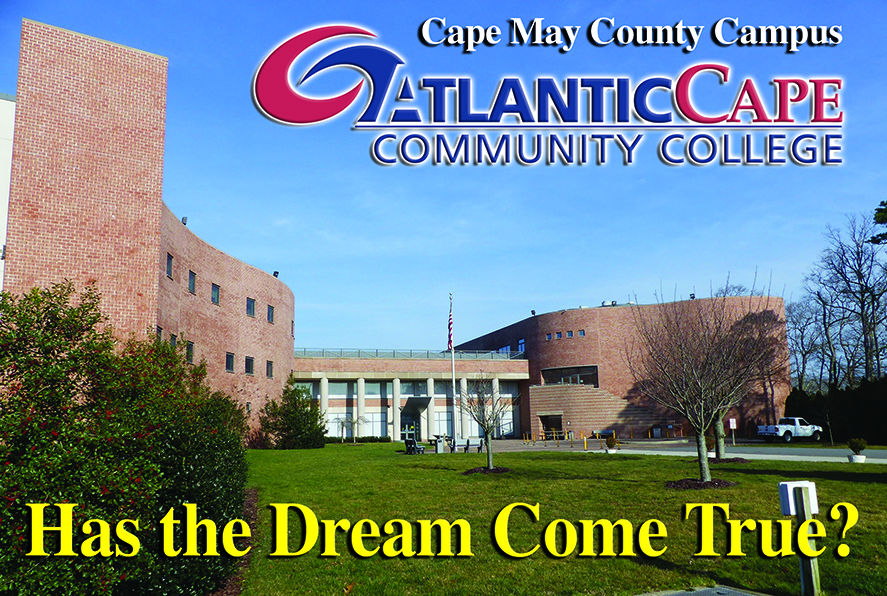COURT HOUSE – In 2016, the Herald published a series of articles on the first decade of Atlantic Cape Community College’s Cape May County Campus entitled “Has the Dream Come True?”
The series showed that following a peak enrollment point in 2010, Atlantic Cape as a whole, and the Cape May Campus more specifically, witnessed several years of declining enrollments and, in the case of Cape May County, saw a greatly underutilized campus facility.
Newly-appointed President Barbara Gaba recently addressed the Cape May County Chamber of Commerce in which she stressed the need for Atlantic Cape to pay greater attention to its southern partner.
In her talk, Gaba stressed that Atlantic Cape “will be directing a sharper focus on the needs of Cape May County and the region, with the goal of providing social and economic mobility to our students and contributing to the revitalization of the county and region.”
Three reports unavailable when the Herald began its series are now in circulation.
They provide an updated picture of the challenges facing the new college president. The reports are the Financial Statements for the FY 2016, the President’s Budget Message for FY 2017 and the Institution Profile for 2016. They allow us to update our observations from the series.
Enrollment
The task facing Atlantic Cape must start with reversing the declines that have seen overall credit hours enrolled drop by 25 percent since 2010.
With a budget that is heavily dependent on tuition and fees, continued declines in enrollment deny the institution the financial flexibility to respond directly to county and regional needs. The current FY 2017 budget stands at $40.7 million and projects 59 percent of the needed revenue will come from tuition and fees.
The most recent data shows the decline continues.
The current FY 2017 budget, according to the President’s Budget Message, projects total credit hours enrolled for the fiscal year 2017 at 130,419. If that number proves accurate, it will represent the lowest credit hour total in almost 15 years.
The Herald series showed that the credit hours taken for Cape May County residents in FY 2016 were lower than they had ever been since the opening of the campus in September 2005.
If the projected figures for 2017 hold, one would have to go back to 2002, three years before the new campus, to find comparable county enrollment levels.
Over the life of the Cape May County campus, program offerings available fully on campus to county students have been reduced as a corrective to dropping revenues.
These moves, as the Herald series demonstrated, also reduced the attractiveness of the campus for potential students, a classic case of the chicken and the egg.
Many Cape May County students were forced to go online to complete almost all of the college’s degree programs. It is also worth noting that in 2016, online tuition per credit was almost 25 percent more expensive than the face-to-face tuition.
The numbers tell a tale of greater use of online courses by Cape May County students than their counterparts in Atlantic County.
When the Court House campus completed its first year of operation, less than one in five credits taken by county residents were online. Last year that number was 26 percent, better than one in four credits.
Students who spoke with the Herald while the series was being written indicated that the fact that they could not get their courses in a traditional classroom modality was a deterrent to enrollment. There is no way to quantify the impact on overall enrollments, but once again the problem of resources comes to the surface.
Lower enrollment means fewer programs offered in a traditional mode, and fewer programs offered may mean lower enrollment.
Remediation
Another issue that is often discussed in conjunction with enrollment concerns is remediation. A significant segment of the students graduating from high schools, in both counties, represent students unprepared for college-level courses.
To date, the solution had largely been placing those students in remedial courses for English and/or Math.
Institution profiles prepared and published by the college show that 59 percent of first-time, full-time students (FTFT) begin with enrollment in remedial courses.
This is the core recruiting group for Atlantic Cape.
As the series also showed, the college focused largely on recruiting students exiting high school and seeking a two-year degree with the potential transfer to a four-year school.
Unlike many community colleges that place a significant part of their recruitment effort on non-traditional older students, the Atlantic Cape concentration of the new high school graduate left the institution more vulnerable to the demographic downturn in the size of regional high school graduation classes.
It is important also to note that remedial work does not count toward the degree. Thus it complicates the ability to get financial aid. Students frequently find they must pay for the courses to develop competencies they should have developed at the high school level where they did not pay.
Enrollment strategy aside, the numbers from the college’s profiles do not suggest that the remediation problem has changed much over the entire period that the Cape May Campus has been in existence.
When the campus opened in 2005, the same 59 percent of FTFT enrollments were in remedial courses.
This does not just impact new full-time students. The numbers also show that one in four of all enrollments were in remedial courses, 24 percent in the fall of 2015. That represents a staggering challenge not just for maintaining enrollment levels but also for degree completion.
Statistics are clear that students “trapped” in remedial courses are more likely to leave and not re-enroll the following year.
Atlantic Cape has consistently had problems with retention. This is not uncommon with community colleges, but retention rates that show the institution losing almost 40 percent of its full-time students after one year and better than 60 percent of its part-time students is another broad challenge to the much-needed tuition revenue.
Remediation is not the only problem contributing to retention issues. Curriculum relevance links to job placements, options for “reskilling” older students are all part of the equation in designing successful enrollment strategies.
Equally the burdens of attending college while working or trying to readjust to an academic environment after a period away from education contribute as well.
Making progress on the remediation issue and getting students into their desired course work without the same financial aid complications, may be critical to retaining more students.
Gaba referenced this remediation problem when she spoke of added efforts by Atlantic Cape to partner with area high schools.
Speaking specifically of a program with Middle Township High School, she spoke of a larger goal of “having students fulfill their developmental requirements before graduating high school.”
With remediation levels stubbornly where they have always been over a 10-year span, the challenge will not be an easy one.
Budget
Even with a decline in overall enrollments of 25 percent from the high point in 2010, the budget at Atlantic Cape is still basically at the same level it was then.
According to the statistical table in Atlantic Cape’s latest annual financial report, the education and general budget, essentially the college’s operating budget, in FY 2010 was $40.2 million.
In FY 2017 it is $40.7 million. The numbers suggest that it takes just as much money to run the college with 25 percent fewer enrollments as it took at the height of the school’s enrollment curve.
Inflation accounts for some of the reason the institution has had to maintain the budget level, but more likely it is a result of classes costing the same to teach at lower average class size levels.
Costs do not vary as directly with class size as does revenue.
Student service costs have also risen as the student body has declined. Attempts to increase retention in the face of recruitment difficulties dictate greater spending on student services. Gaining and retaining students comes at a higher cost in an environment of declining overall enrollments.
In FY 2010, 9 percent of the education and general budget went to student services. In FY 2017, that number stands at 12 percent. That represents over $1 million that had to be taken from elsewhere and moved.
The new career centers represent an attempt by the college to help focus the student on career options. Statistics show that such a focus is a positive factor for retention.
Yet students who spoke with the Herald during the writing of the earlier series noted that the efforts on career focus do not extend to actual help with jobs. The college, like some other community colleges, has no formal job placement office.
Tuition
It is also clear that the necessity of having almost 60 percent of the budgets come from tuition and fees, even in the face of fewer overall credit hour enrollments, means that tuition and fees have to continue to rise.
In the period from 2010 to 2017, that increase in tuition has been 29 percent based on the President’s Budget Messages. Fees are additional to the tuition. In that same period, overall, fees have risen faster than tuition.
It is true that community colleges in the state offer the least expensive path to gaining the first two years of a college curriculum. A recent report by Student Loan Hero, a website that focuses on student loans, shows that New Jersey students save more than students in any other state by attending a community college first and then going on to a state four-year institution.
Atlantic Cape is among the state community colleges offering the greatest potential savings because its per-credit tuition is lower than the average for state public two-year institutions.
This report was part of a recent release from Atlantic Cape. Yet the value demonstrated in the report accrues to that small group of students who enter a community college academically prepared and specifically aiming to go on to a four-year school.
This group is part of a demographic trend that is declining in both counties.
A bright spot in the enrollment trends has been the nursing programs which have grown by over 40 percent since 2010, but that growth has been offset by an equally steep decline of over 40 percent in enrollments in the culinary program.
Cape May County students, at one point, accounted for 38 percent of the credit-hour enrollments in the culinary program. At present, they account for only 20 percent of a much smaller total.
There are lessons in those numbers. The nursing program plays directly to areas where employment opportunities exist in both counties.
One would think the culinary program does as well, but it has been impacted by the casino industry woes in Atlantic City.
In Cape May County it was just another one of those programs a student could not get without travel to Mays Landing.
The Challenge
The Atlantic Cape campus in Cape May County is a greatly underutilized facility. In its decade and more of existence, it never became central to the county’s cultural or intellectual life.
The enrollment declines leave its parking lot largely empty much of the week. A common student complaint is that there are no attractions inside the building that would draw students to the campus when not scheduled for a class.
Given that the county appropriation to the college was established as enrollment-based funding, Cape May County’s annual contribution to the college budget has declined.
In FY 2010, the budget showed an expected appropriation from the county of over $2 million. In FY 2017 it stood at $1.67 million.
Credit hours taken by Cape May County students have decreased faster than credit-hour enrollment by Atlantic County students, although both are in decline.
That means in terms of both county appropriations and county student tuition dollars; Cape May County is contributing less to the institution’s bottom line.
What the most recent reports show is the decline continues apace, and the challenges facing those seeking a more vibrant campus in Cape May County are growing.
To contact Vince Conti, email vconti@cmcherald.com.







